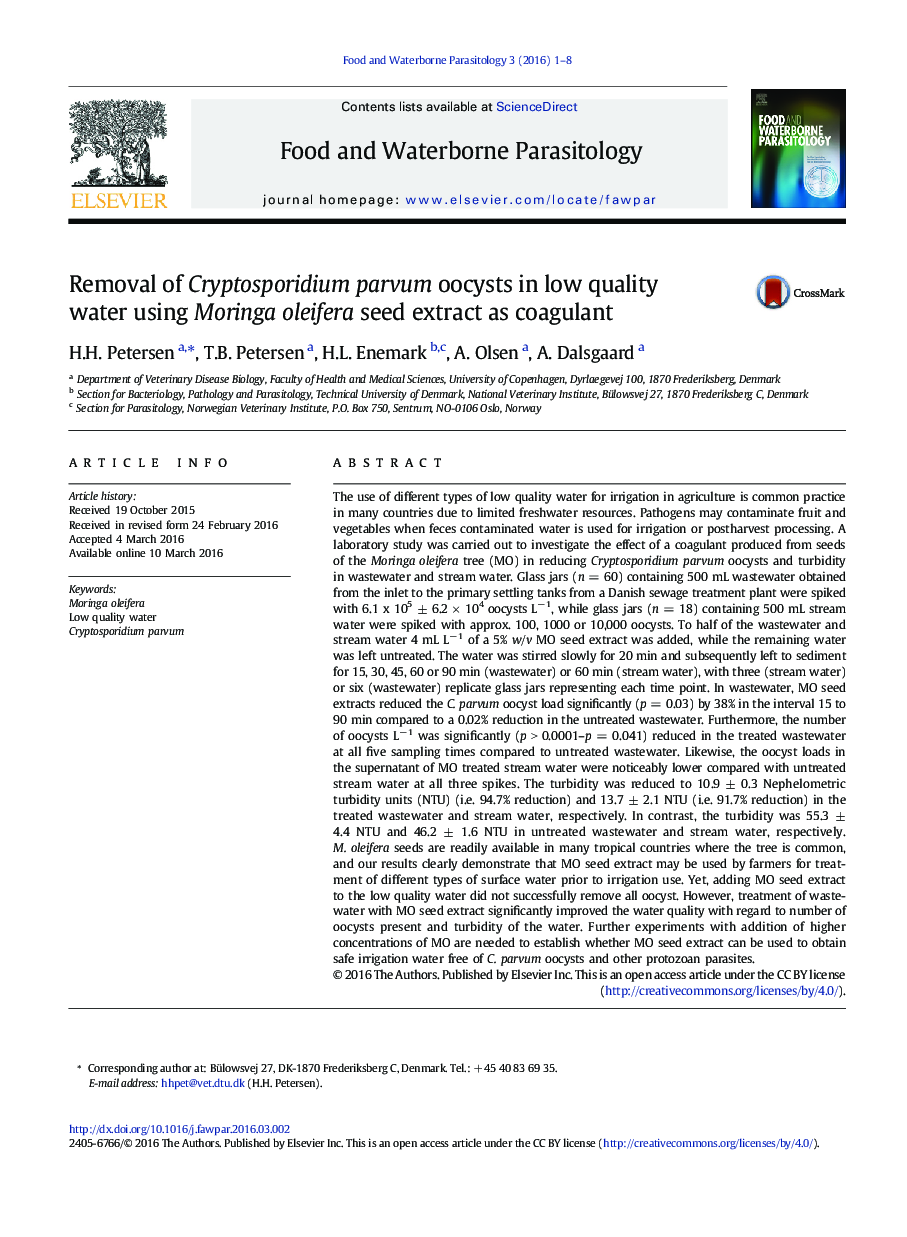| کد مقاله | کد نشریه | سال انتشار | مقاله انگلیسی | نسخه تمام متن |
|---|---|---|---|---|
| 2473631 | 1555931 | 2016 | 8 صفحه PDF | دانلود رایگان |
• Adding MO seed extract to wastewater significantly reduced C. parvum oocysts.
• Oocyst numbers in MO treated water was reduced by 60% compared to untreated water.
• Adding MO seed extract to wastewater significantly lowered the turbidity.
• The turbidity in MO treated water was reduced by 80.3%compared to untreated water.
The use of different types of low quality water for irrigation in agriculture is common practice in many countries due to limited freshwater resources. Pathogens may contaminate fruit and vegetables when feces contaminated water is used for irrigation or postharvest processing. A laboratory study was carried out to investigate the effect of a coagulant produced from seeds of the Moringa oleifera tree (MO) in reducing Cryptosporidium parvum oocysts and turbidity in wastewater and stream water. Glass jars (n = 60) containing 500 mL wastewater obtained from the inlet to the primary settling tanks from a Danish sewage treatment plant were spiked with 6.1 x 105 ± 6.2 × 104 oocysts L− 1, while glass jars (n = 18) containing 500 mL stream water were spiked with approx. 100, 1000 or 10,000 oocysts. To half of the wastewater and stream water 4 mL L− 1 of a 5% w/v MO seed extract was added, while the remaining water was left untreated. The water was stirred slowly for 20 min and subsequently left to sediment for 15, 30, 45, 60 or 90 min (wastewater) or 60 min (stream water), with three (stream water) or six (wastewater) replicate glass jars representing each time point. In wastewater, MO seed extracts reduced the C. parvum oocyst load significantly (p = 0.03) by 38% in the interval 15 to 90 min compared to a 0.02% reduction in the untreated wastewater. Furthermore, the number of oocysts L− 1 was significantly (p > 0.0001–p = 0.041) reduced in the treated wastewater at all five sampling times compared to untreated wastewater. Likewise, the oocyst loads in the supernatant of MO treated stream water were noticeably lower compared with untreated stream water at all three spikes. The turbidity was reduced to 10.9 ± 0.3 Nephelometric turbidity units (NTU) (i.e. 94.7% reduction) and 13.7 ± 2.1 NTU (i.e. 91.7% reduction) in the treated wastewater and stream water, respectively. In contrast, the turbidity was 55.3 ± 4.4 NTU and 46.2 ± 1.6 NTU in untreated wastewater and stream water, respectively. M. oleifera seeds are readily available in many tropical countries where the tree is common, and our results clearly demonstrate that MO seed extract may be used by farmers for treatment of different types of surface water prior to irrigation use. Yet, adding MO seed extract to the low quality water did not successfully remove all oocyst. However, treatment of wastewater with MO seed extract significantly improved the water quality with regard to number of oocysts present and turbidity of the water. Further experiments with addition of higher concentrations of MO are needed to establish whether MO seed extract can be used to obtain safe irrigation water free of C. parvum oocysts and other protozoan parasites.
Journal: Food and Waterborne Parasitology - Volume 3, June 2016, Pages 1–8
